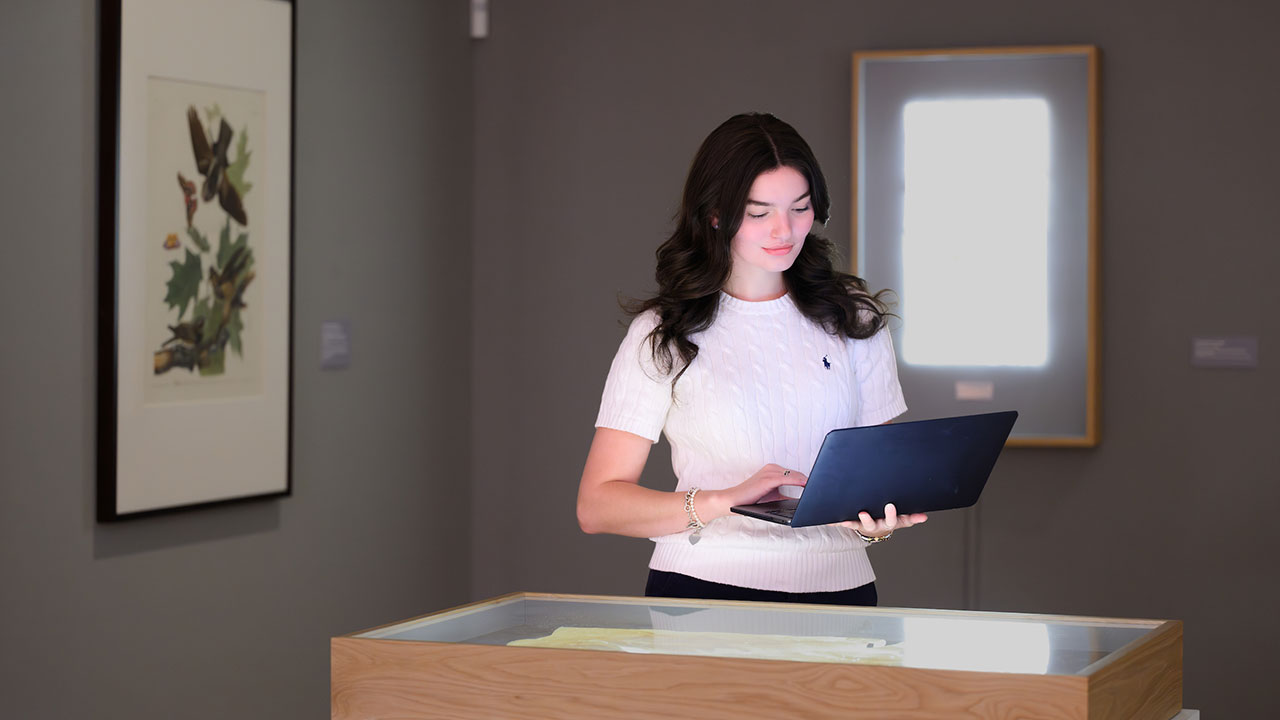content body

Auburn student Katelyn Zeeveld has been analyzing artwork from the database of the university art collection and writing alt text descriptions for each.
With more than 3,000 collection objects and counting, the Jule Collins Smith Museum of Fine Art has strived to further accessibility to art through the use of alternative text.
Alternative text, also known as alt text, is a written description of a piece of artwork that provides visually impaired audiences with descriptive aids to better experience art on a digital platform.
Katelyn Zeeveld, a sophomore majoring in art history at Auburn University, has been working on the project for nearly two years, analyzing artwork from the database of the university art collection and writing alt text descriptions for each.
“Before my training at The Jule on alt text, I had not been aware of their efforts, however I was eager to contribute to its impact on the viewer experience,” Zeeveld said. “I was immediately met with difficulty in only describing physical properties. As an art history major, I am forced to analyze deeper meanings in an image, so I had to retrain my brain to look at the surface before thinking further.”
After adapting to a new style of writing, Zeeveld quickly learned what it takes to write alt text descriptions. In accordance with the Cooper Hewitt Guidelines for Image Description, all of her alt text descriptions are less than 20 words, or 125 characters, and put as much description as possible within that constraint.

The Jule Collins Smith Museum of Fine Art's alt text initiative is a passion project for Katelyn Zeeveld, who has an uncle who is legally blind.
Her expertise is shown in a depiction of John James Audubon’s “Bay-Winged Bunting" (1830) and describes the art as, “A white-breasted, brown-winged bird perches atop a rock in front of a sprawl of yellow-flowered cacti.” Her efforts with this project have taught her to apply her new skill of thinking about art more objectively to the classroom as well.
Museum Executive Director Cindi Malinick added that museum staff members are working on further incorporating this and other inclusive enhancements, from alt text descriptions on artwork labels to large font gallery materials for people with vision impairments. She affirms this project also benefits students’ professional development.
“Today’s employers value soft skills like written communication and critical thinking. Looking at an object and developing content are prime examples of these skills in action,” Malinick said.
Many students with visual impairments and community members alike can now benefit from Zeeveld and the rest of the staff's work. One of these students is Luke Metcalfe, an aerospace engineering major at Auburn.
“The way I view art is like a color wheel,” Metcalfe said. “The sky is yellow and grass is red, colors are opposite and I can't see any detail unless I'm inches away. When I go to museums, I’ll take pictures of the art with my phone and then zoom in to blow up the picture to see it.”
Metcalfe experienced severe eyesight loss at a young age after a sinus infection caused a buildup of pressure in his sinuses and damaged his optic nerves. He has since been almost entirely blind and utilizes alt text when available. One of his more recent encounters with alt text was also with the university on the undergraduate admissions portal.
“They used alt text to prompt me to click on everything in a timely manner and help me get through the admissions portal,” Metcalfe said. “It was really nice, and I think it ultimately gives blind people a little more independence.”

Luke Metcalfe, an aerospace engineering student, has vision issues and will greatly benefit from the museum's alt text project. (Photos courtesy of Luke Metcalfe)
His limited vision allows him to glean some of the art displayed in museums, but he is not the norm.
There are others who are completely unable to view the art. In addition, they also often lack the resources to travel to a gallery, and when they do, they feel left out of the experience. Alt text can sometimes be the only way for them to experience art in its intended form.
The final description for each artwork is actually a composite of three different entries by individual students that are then revised by others, ensuring varied points of view.
“By including multiple student voices in crafting alt text descriptions, we are moving beyond a single institutional perspective to create a deeper level of interpretation at The Jule,” Malinick said. “This initiative ensures Auburn’s art museum is accessible to all, fostering a space where everyone can engage with the objects within, regardless of background or ability.”
Metcalfe adds that use of alt text in museums will provide more accessibility among people with visual impairments and allow them to take part from the comfort of their own homes.
“Alt text is a facet of inclusion,” Metcalfe said. “I think it’s a wonderful thing.”
Zeeveld, who has an uncle who is legally blind, agrees the impact of a project such as this one will be substantial.
“This project has the possibility to make art more accessible to all patrons, changing the viewer experience overall,” Zeeveld said. “When art has no boundaries, it has the ability to make a greater impact.”





